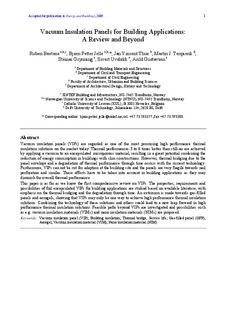| dc.contributor.author | Baetens, Ruben | |
| dc.contributor.author | Jelle, Bjørn Petter | |
| dc.contributor.author | Thue, Jan Vincent | |
| dc.contributor.author | Tenpierik, Martin J. | |
| dc.contributor.author | Grynning, Steinar | |
| dc.contributor.author | Uvsløkk, Sivert | |
| dc.contributor.author | Gustavsen, Arild | |
| dc.date.accessioned | 2017-03-30T14:15:19Z | |
| dc.date.available | 2017-03-30T14:15:19Z | |
| dc.date.created | 2009-11-27T15:20:13Z | |
| dc.date.issued | 2010 | |
| dc.identifier.citation | Energy and Buildings. 2010, 42 (2), 147-172. | nb_NO |
| dc.identifier.issn | 0378-7788 | |
| dc.identifier.uri | http://hdl.handle.net/11250/2436397 | |
| dc.description.abstract | Vacuum insulation panels (VIPs) are regarded as one of the most promising high performance thermal insulation solutions on the market today. Thermal performances 3 to 6 times better than still-air are achieved by applying a vacuum to an encapsulated microporous material, resulting in a great potential combining the reduction of energy consumption in buildings with slim constructions. However, thermal bridging due to the panel envelope and a degradation of thermal performance through time occurs with the current technology. Furthermore, VIPs can not be cut for adaption at the building site and the panels are very fragile towards nail perforation and similar. These effects have to be taken into account in building applications as they may diminish the overall thermal performance.
This paper is as far as we know the first comprehensive review on VIPs. The properties, requirements and possibilities of foil encapsulated VIPs for building applications are studied based on available literature, with emphasis on the thermal bridging and the degradation through time. An extension is made towards gas-filled panels and aerogels, showing that VIPs may only be one way to achieve high performance thermal insulation solutions. Combining the technology of these solutions and others could lead to a new leap forward in high performance thermal insulation solutions. Feasible paths beyond VIPs are investigated and possibilities such as e.g. vacuum insulation materials (VIMs) and nano insulation materials (NIMs) are proposed. | nb_NO |
| dc.language.iso | eng | nb_NO |
| dc.publisher | Elsevier | nb_NO |
| dc.title | Vacuum Insulation Panels for Building Applications: A Review and Beyond | nb_NO |
| dc.type | Journal article | nb_NO |
| dc.type | Peer reviewed | nb_NO |
| dc.source.pagenumber | 147-172 | nb_NO |
| dc.source.volume | 42 | nb_NO |
| dc.source.journal | Energy and Buildings | nb_NO |
| dc.source.issue | 2 | nb_NO |
| dc.identifier.doi | 10.1016/j.enbuild.2009.09.005 | |
| dc.identifier.cristin | 500737 | |
| dc.description.localcode | (c) 2009 Elsevier B.V. All rights reserved. This is the authors' accepted and refereed manuscript to the article, post-print. Released with a Creative Commons Attribution Non-Commercial No Derivatives License. | nb_NO |
| cristin.unitcode | 194,64,35,0 | |
| cristin.unitcode | 194,61,25,0 | |
| cristin.unitname | Institutt for bygg, anlegg og transport | |
| cristin.unitname | Institutt for byggekunst, historie og teknologi | |
| cristin.ispublished | true | |
| cristin.fulltext | original | |
| cristin.fulltext | postprint | |
| cristin.qualitycode | 2 | |
